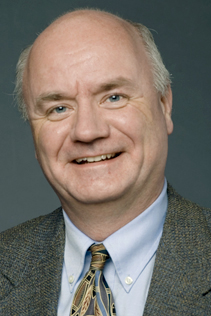Fall 2012
 |
|
| GRAPE |
The Gamma Ray Polarimeter Experiment, or GRAPE, was recently renewed for another three years with $1.1 million in funding from the NASA Astrophysics program, says principal investigator Mark McConnell. The balloon-based experiment had an initial flight in 2011 and the new funding will provide for instrumentation improvements and a second balloon launch scheduled to take place in the fall of 2014 from Ft. Sumner, New Mexico. Peter Bloser and Jason Legere will continue to play a significant role in the project.
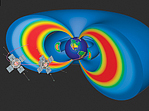 |
|
| RBSP |
Launched on August 30th, the twin Radiation Belt Storm Probes (RBSP) wasted no time gathering seminal data from this complex, dynamic, and hazardous region of geospace. Indeed, only days after launch, the Relativistic Electron Proton Telescope on the Energetic Particle, Composition, and Thermal Plasma Suite, or ECT, witnessed a remarkable radiation belt event, an event that is already generating much scientific excitement. And in early October the Electric and Magnetic Field Instrument Suite and Integrated Science (EMFISIS) experiment recorded what has been dubbed "Earthsong." It is clearest recording ever made of an electromagnetic phenomenon known as "chorus" and thought to be one of the most important waves for energizing the electrons that make up the outer radiation belt. Since then, the other ECT instruments, the Magnetic Electron Ion Spectrometer and the Helium Oxygen Proton Electron instruments have been commissioned and are collecting outstanding science data. EOS director Harlan Spence is the principal investigator for ECT and SSC director Roy Torbert is a coinvestigator on EMFISIS. All of the RBSP science instrument teams completed adjusting and fine-tuning their instruments before heading into the full-scale science phase, which began officially on October 29.
Chuck Smith reports that several undergraduate students working with him, Bernie Vasquez, and Phil Isenberg have attended key space physics conferences and are working on papers for publication. Jesse Coburn attended the Solar Wind 13 and SHINE 2012 conferences in June where he presented work on analyses of energy cascade rates in the solar wind. Brad Cannon was awarded a summer internship to continue a collaboration with Jet Propulsion Laboratory colleague Neil Murphy and is finishing two papers on newborn interstellar pickup ions as a result of his summer's work. Steve Orlove is preparing a paper on solar dynamics using solar wind measurements within large-scale rarefaction regions. Matt Stemkowski coauthored a paper on correlation functions in solar wind turbulence that has been submitted to the proceedings of Solar Wind 13. And graduate student Kristoff Paulson, along with RPI undergraduate David Taylor, who worked within EOS this summer, had a paper accepted that details how weak interplanetary shocks can serve as important harbingers of approaching transient solar wind.
The Interstellar Boundary Explorer (IBEX) has completed its fourth year in orbit after being launched October 19, 2008. Last year, the spacecraft was maneuvered into a unique, stable orbit that should accommodate a lifetime of several decades for the mission. IBEX has opened a new window onto the global heliosphere and properties of the local galactic environment.
 |
|
| Trevor Leonard |
At the end of October, the IBEX Science Working Team Meeting was held in Santa Fe, N.M. and was supported by UNH-SSC faculty Harald Kucharek, Martin Lee, Eberhard Möbius, and Nathan Schwadron, as well as graduate students Jeewoo Park and Trevor Leonard. While Lee, Schwadron, Park, and Leonard presented new findings on the four species of the interstellar wind that IBEX is capturing, Kucharek and Möbius discussed two models of how to explain the surprising "IBEX Ribbon," which was discovered by the mission and has since caused intense, ongoing debates as to its origin. Future mission science operations led by UNH had a prominent place in the meeting, as did work on a Senior Review proposal to NASA in which the anticipated operations and expected future observations of the mission are laid out. Says Schwadron, "As IBEX continues to track the evolution of the global heliosphere and properties of the local galactic environment over the solar cycle, it enables us to tackle fundamental open questions about the outer boundaries of our solar system."
 |
|
| Taylor Connor |
In additional IBEX news, physics Ph.D. candidate Leonard is one of three co-chairs for an IBEX session at the upcoming 2012 AGU Fall Meeting—a "great feat for a graduate student," notes Möbius. The title of the oral and poster sessions is "Our Heliosphere, IBEX, and the Cosmos." Leonard has been working with Möbius studying the neutral interstellar medium flow inside the heliosphere. "Organizing the session has provided invaluable experience, exposed me to a variety of studies related to my field, and forced me to examine each study critically," Leonard says.
Ph.D. candidate Taylor Connor will defend his dissertation in November. His doctoral work describes the development of the Gamma Ray Polarimeter Experiment (GRAPE), which is designed to measure the polarization of gamma rays from astronomical sources. GRAPE has largely defined Connor's doctoral experience. His results are derived from the successful 2011 balloon campaign that focused on observations from the Crab Nebula. The measurements lead to a better understanding of both the emission mechanisms and source geometries of celestial bodies.
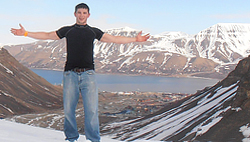 |
|
| Drummond Biles |
Senior mechanical engineering major Drummond Biles, working with advisor Marc Lessard in the Magnetosphere-Ionosphere Research Laboratory, has been developing a method for calibrating an all-sky camera for use at the Kjell Henriksen Observatory. The project, which took him to Svalbard, Norway this past summer, is in collaboration with the University Centre in Svalbard in Longyearbyen, Spitsbergen, which supplemented funding in addition to the UNH International Research Opportunity Program grant Biles received.
 |
|
| Doug Vandemark |
Director of OPAL Doug Vandemark attended a string of international meetings over the past few months that were focused primarily on satellite oceanography. He presented ongoing work under four NASA-sponsored grants to EOS at the Aquarius/SAC-D Science Team Meeting in Buenos Aires (for the Aquarius ocean salinity observing satellite), the NASA Ocean Vector Winds Science Team Meeting in Utrecht, Netherlands, the European Space Agency's 6th Coastal Altimetry Workshop in Riva del Garda, Italy, which he helped organize, and the ESA-hosted "20 years of Progress in Radar Altimetry" symposium also held in Italy. Most recently Vandemark attended the Aquarius Satellite Calibration and Validation Meeting held in October in Washington, D.C.
Tim Moore received a grant from the National Institutes of Health of nearly $600K for a three-year collaborative project between UNH, Michigan Tech University, and Wetlabs—a private company in Rhode Island. The team will develop remote sensing algorithms for the detection and prediction of Microcystis—a poisonous alga that proliferates in freshwater lakes, in particular Lake Erie and Saginaw Bay in Lake Huron. They will deploy in-water instrumentation to gather environmental data and develop algorithms using optical and environmental data collected in the region. Ultimately, the algorithms will help agencies with public notification and mitigation strategies.
 |
|
| Jamie Cournane |
Jamie Cournane co-authored a paper titled "Organismal biology in the age of ecosystem-based management" with Jacob Kritzer of the Environmental Defense Fund that was published in October in Advancing an Ecosystem Approach in the Gulf of Maine by the American Fisheries Society. Cournane has another paper, "Spatial and temporal patterns of anadromous alosine bycatch in the Atlantic herring fishery," in-press in the journal Fisheries Research with co-authors Kritzer and Steven Correia of Massachusetts Division of Marine Fisheries. Cournane also reports that she and Christopher Glass presented their fisheries research at the International Council for the Exploration of the Sea Annual Science Conference in Bergen, Norway in September.
Emily Klein was a co-author with Michael Fogarty of NOAA and David Townsend of the University of Maine on a paper titled "Advances in Understanding Ecosystem Structure and Function in the Gulf of Maine." The paper was also published in the book Advancing an Ecosystem Approach in the Gulf of Maine. The special publication summarizes proceedings of the Gulf of Maine Symposium held in St. Andrews, New Brunswick, Canada in October 2009.
 |
|
| Chris Hunt |
Chris Hunt participated in the Surface Ocean Carbon ATlas (SOCAT) Coastal Data workshop in Seattle, October 2-4. The SOCAT database compiles surface ocean carbon dioxide measurements from around the world and the workshop was part of developing Version 2 of the database. That will bring the total number of measurements to over nine million. The workshop brought together data contributors from the USA and Japan, who graded and quality-controlled over 900 submissions of new shipboard carbon dioxide data.
Mark Twickler and Joe Souney received an award from the National Science Foundation's Division of Polar Programs for their proposal "Collaborative Research: A 1500m Ice Core from South Pole." A joint project with UC-Irvine, the University of Washington, and NASA-Goddard, the goal is to collect an ice core during the 2014-15 and 2015-16 Antarctic field seasons to provide an environmental record spanning approximately 40,000 years. Twickler is the scientific coordinator for the National Ice Core Laboratory Science Management Office housed in the ESRC. Souney is project operations manager. The South Pole project will support a wide range of ice core science projects and contribute to the societal need for a basic understanding of climate and the capability to predict climate and ice sheet stability on long time scales.
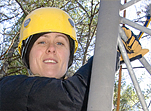 |
|
| Elizabeth Burakowski |
Cameron Wake and Elizabeth Burakowski kicked off the new Seacoast Science Café series at the Portsmouth Brewery September 19 and October 17, respectively. The Wednesday evening series, a collaboration between the New Hampshire EPSCoR program, UNH, and the brewery, offers the opportunity for members of the public to discuss trends and perceptions of our changing climate directly with scientists. Wake, along with Larry Hamilton of the Carsey Institute, fielded questions from a packed house attending the "What Do We Really Know and Believe About Climate Change?" inaugural event. "The whole idea is to create a comfortable atmosphere for dialogue as opposed to us lecturing," notes Wake, adding that the audience was "totally engaged" with discussion focused on finding solutions rather than questioning the validity of climate change science. Burakowski, a Ph.D. student, and state climatologist Mary Stampone from the UNH department of geography, addressed issues around the theme "Getting to Know Snow: Volunteer Climate Scientists Take an In-Depth Look at NH Snow." Burakowski's doctoral work is funded through a NH EPSCoR project titled "Ecosystems and Society" and involves a citizen-science group making measurements of snow reflectance or "albedo" throughout the state. On November 14, Scott Ollinger will present "Forest Ecosystems and the Winds of Change: The History and Future of Forests as a Cog in the Earth System."
The UNH Foundation announced that Cameron Wake has been named as the first recipient of the Josephine A. Lamprey Fellowship in Climate and Sustainability, a gift that supports a five-year fellowship designed to promote more focus on the climate and energy issues that interconnect with biodiversity and ecosystems, food systems and culture under sustainability. The gift was made to the university's Sustainability Institute by Jo Lamprey, retired president of Lamprey Brothers, a local company providing heating and cooling solutions since the late 1800s. The support provided to Wake will allow him to advance the Sustainability Institute's regional efforts aimed at shifting New England towards energy independence, as well as adapting to changes in climate that the region is already experiencing.
Erik Hobbie attended the 2012 Association of Ecosystem Research Centers Symposium in Washington, D.C. on October 18-19. The conference theme was "The Role Of Ecosystem Science In National Security" and included talks on human ecology and human security, global freshwater resources, food security, environmental consequences of energy production in the US, and infectious diseases and biosecurity. Talks were webcast and can be accessed at http://www.ecosystemresearch.org/2012-meeting/index.htm.
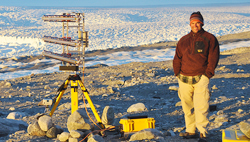 |
|
| Ryan Cassotto |
In August, graduate student Ryan Cassotto deployed a ground-based portable radar interferometer at a Greenland tidewater outlet glacier to gain a better understanding of the dynamics along the glacier's terminus. Cassotto, a second-year Ph.D. student, is studying the deformation and flow properties of materials at the Earth's surface. He will use the Greenland observations to demonstrate how stress changes along the glacier's periphery affect the overall flow of the glacier. Cassotto is working with co-advisor Margaret Boettcher, assistant professor of geophysics in the UNH department of Earth sciences, to perform a similar study of landslide properties in the western U.S. The radar is manufactured by Gamma Remote Sensing and was procured by ESRC affiliate associate professor and glaciologist Mark Fahnestock of the University of Alaska Fairbanks, also Cassotto's co-advisor, through a research grant from the Betty and Gordon Moore Foundation.
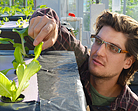 |
|
| Calvin Diessner |
Master's student Calvin Diessner is conducting an investigation into an alternative form of aquaculture known as aquaponics—an innovative method of farming where fish are grown in conjunction with plants in a closed recirculating system. Although fish waste provides the nutrients necessary for plant growth, essential macronutrients are deficient when fish are fed standard diets. Supplements often added to optimize plant growth create "enriched" water tolerated by only certain species of fish. Diessner's research uses hybrid striped bass to investigate the co-culture of this fish with plant species that have lower requirements for these macronutrients.
EOS affiliate professor and UNH provost and vice president for academic affairs John Aber was honored by the Yale University Graduate School of Arts and Sciences with the Wilbur Lucius Cross Medal, which recognizes alums for distinguished achievements in the areas of scholarship, teaching, academic administration and public service. Aber, a forest ecologist, received his Ph.D. from Yale in 1976. He is internationally known for his groundbreaking work on nitrogen cycling, sustainable ecosystem management, climate change, and the effects of acid rain on forests.
